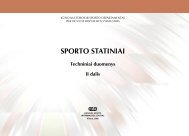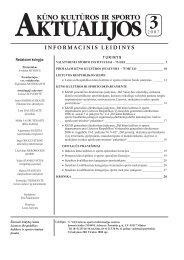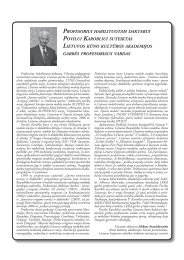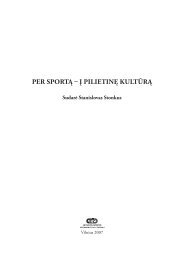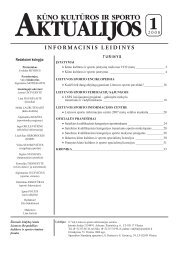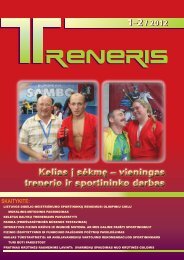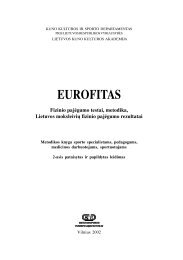Nr. 1 - Lietuvos sporto informacijos centras
Nr. 1 - Lietuvos sporto informacijos centras
Nr. 1 - Lietuvos sporto informacijos centras
You also want an ePaper? Increase the reach of your titles
YUMPU automatically turns print PDFs into web optimized ePapers that Google loves.
2010 <strong>Nr</strong>. 1(59)<br />
27<br />
in males. Journal of Bone and Mineral Research, 18 (11):<br />
1964–1969.<br />
4. Hellard, P., Avalos, M., Lacoste, L., Barale, F., Chatard,<br />
J-C., Millet, G. P. (2006). Assessing the limitations of the<br />
Banister model in monitoring training. Journal of Sports<br />
Sciences, 24(5), 509–520.<br />
5. Lyle, J. (2006). Sports Coaching Concepts: A framework<br />
for Coaching Behaviour. Routledge: London.<br />
6. Martens, R. (2004). Successful Coaching. Human Kinetics.<br />
7. Mill, G. P., Candau, R. B., Barbier, B., Busso, T., Rouillon,<br />
J. D., Chatard, J. C. (2002). Modeling the transfers of training<br />
effects on performance in elite triathletes. International<br />
Journal of Sports Medicine, 23 (1): 55–63.<br />
8. Mujika, I., Goya, A., Ruiz, E., Grijalba, A., Sansisteban,<br />
J., & Padilla, S. (2002). Physiological and performance<br />
responses to a 6-day taper in middle-distance runners:<br />
Influence of training frequency. Internationals Journal of<br />
Sports Medicine, 23: 367–373.<br />
9. <strong>Nr</strong>dström, P., Lorentzon, R. (1996). Site-specific bone mass<br />
differences of the lower extremities in 17-year old ice hockey<br />
players. Calcified Tissue International, 59(6): 443–448.<br />
10. Prognosis of competitive performances in elite<br />
swimming. In: J. R. Blackwell & R. H. Sanders (Eds),<br />
Proceedings of Swim Sessions, XIX International Symposium<br />
on Biomechanics in Sports (pp. 100–103). San Francisco:<br />
University of San Francisco.<br />
11. Reilly, T. (2007). The Science of Training - Soccer.<br />
London: Routledge.<br />
12. Букатин, А. Ю., Колузганов, В. М. (1986). Юный<br />
хоккеист. Москва: Физкультура и Спорт.<br />
13. Быстров, В. А. (2000). Основы обучения и тренировки<br />
юных хоккеистов. Москва: Терра спорт.<br />
14. Платонов, В. Н. (2004). Общая теория подготовки<br />
спортсменов в олимпийском спортe. Киев: Олимпийская<br />
литература.<br />
OPTIMIZATION OF PHYSICAL TRAINING OF ICE HOCKEY PLAYERS AGED 8-17 YEARS<br />
The objective of the resarch was to determine the<br />
models of physical training of ice hockey players aged<br />
8-17 years. A long-term single-alternative experimental<br />
research has been carried out during the years 1997 -<br />
2007. Children (n =17) aged from 8 to 17 years have<br />
served as subjects of this research. We did research in<br />
the changes of indices in the process of developing the<br />
main physical properties, such as explosive strength,<br />
speed, agility, endurance. To determine agility a special<br />
test was applied. To determine explosive strength jump<br />
with hand swing from a contact platform was used.<br />
The test also included long jump from standing and the<br />
strength of the hand grip was measured with the help of<br />
a dynamometer. The tests of assessing general physical<br />
fitness were as follows: 20 m and 30 m run from standing<br />
start, 20 m run from flying start (“New Test” equipment),<br />
300 m run and pull-ups on the horizontal bar.<br />
The analysis of dynamics of physical fitness results<br />
during the three years period of initial training shows<br />
that the improvement of results was not uniform. The<br />
greatest difference in the improvement of results was<br />
observed between the 1 st and 2 nd years of sport training,<br />
namely: explosive strength (jump up with hand swing) -<br />
26,9%, long jump from standing - 11,5%, strength<br />
endurance - (push ups) - 18,3%, hands grip strength -<br />
24%, agility (special test) - 9,6% (p< 0, 001).<br />
The period of basic training (11 - 13 years). The<br />
analysis of dynamics of physical fitness results during the<br />
______________________________________________________________________________________________________________________________________________________<br />
Gracijus Girdauskas<br />
<strong>Lietuvos</strong> kūno kultūros akademija<br />
Sporto g. 6, LT–44221 Kaunas<br />
Mob. +370 618 35 220<br />
El. paštas: gracijus.girdauskas@gmail.com<br />
Assoc. Prof. Dr. Gracijus Girdauskas, Birutė Girdauskienė, Rimas Kazakevičius<br />
Lithuanian Academy of Physical Education<br />
Summary<br />
three years of this period of training shows the greatest<br />
difference in the improvement of results (p< 0, 05) to be<br />
between the 1 st and 2 nd years of training, namely: strength<br />
endurance (push ups) - 21,1%, hand grip strength - 5,9%,<br />
speed (20 m run from flying start) - 5,6%, explosive<br />
strength (long jump from standing) - 5,4%, special<br />
endurance (300 m run) - 4.8% (p< 0,05).<br />
During the period of special training the greatest<br />
difference in the improvement of physical fitness results<br />
was seen between 1 st and 2 nd years of sport training,<br />
namely: the strength of right hand grip - 14,6%, the<br />
strength of the left hand grip - 13,2%, strength endurance<br />
(pull ups) - 7,4%, special endurance (300 m run) - 6,5%,<br />
explosive strength (long jump from standing) - 6,2%,<br />
jump up with hand swing - 4,7%, speed (20 m run from<br />
a flying start) - 4,5% (p< 0,05).<br />
Conclusions: 1. The experiment carried out has<br />
verified the efficiency of sports training programmes<br />
applied. 2. Having analyses research results of the<br />
various training stages and having compared them with<br />
model characteristics of other countries we propose the<br />
following models of physical training of ice hockey<br />
players: the initial period of training (8 - 10 years of<br />
age) - 25%; the period of basic training (11 - 13 years<br />
of age) - 34% and the period of special training (14 - 17<br />
years of age) - 30% respectively.<br />
Keywords: physical training, stages of training,<br />
changes in results, training model.<br />
Gauta 2009 02 22<br />
Patvirtinta 2010 04 09



